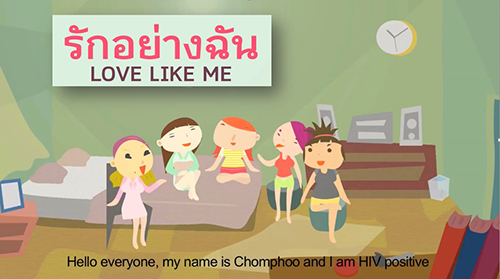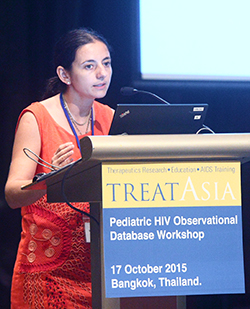Improving Reproductive Health in Young Thai Women
Published Thursday, March 17, 2016

A still from the animated video used to teach young women with HIV about contraceptive options and reproductive health.
Dr. Nadia Kancheva-Landolt of HIV-NAT at the Thai Red Cross AIDS Research Centre has been studying how to improve the reproductive health of HIV-positive young women in Thailand. Dr. Kancheva-Landolt’s recent project, “Optimization of reproductive health care for female adolescents living with HIV,” was conducted at five sites and was among several studies funded through TREAT Asia by ViiV Healthcare to address key research and training gaps in HIV care and treatment for children and adolescents in Asia. The counseling component was funded by UNICEF and directed by an experienced group of local child psychologists and nurses (The We Understand Group). “Previous research has revealed an urgent need to provide specialized reproductive health services for HIV-positive adolescents in the Asia-Pacific region,” said Dr. Kancheva-Landolt.
 Dr. Nadia Kancheva-Landolt speaking on her research on reproductive health among HIV-positive adolescents at the TREAT Asia Network Meeting in Bangkok, Thailand, October 2015.She presented the results of the project’s core study, “Strategies to improve the uptake of effective contraception in HIV-positive adolescents,” at the 6th International Workshop on HIV & Women in Boston, in February. This study assessed factors associated with the initiation and continuing use of a highly effective contraceptive method in HIV-positive adolescents. The methods studied were two short-acting contraception methods (contraceptive pills or depot medroxyprogesterone acetate injection) and two long-acting reversible contraception methods (hormonal implant or intra uterine device). Seventy-seven HIV-positive and sexually active Thai girls and young women aged 12−24 were included. All participants received safe sex education through an animated video, contraceptive information brochures, and individual counseling. All but one showed at least some improvement in knowledge of safe-sex practices after the educational intervention. In general, participants found the individual counseling the most helpful educational method, followed by the video. During the study, the percentage of participants who used effective contraceptive methods in addition to male condoms compared to condoms alone increased from 29% to74%. The use of a long-acting contraceptive also increased during the study. Those who had been pregnant were more likely to have previously used an effective contraceptive method, and were more likely to be using it by the study’s end.
Dr. Nadia Kancheva-Landolt speaking on her research on reproductive health among HIV-positive adolescents at the TREAT Asia Network Meeting in Bangkok, Thailand, October 2015.She presented the results of the project’s core study, “Strategies to improve the uptake of effective contraception in HIV-positive adolescents,” at the 6th International Workshop on HIV & Women in Boston, in February. This study assessed factors associated with the initiation and continuing use of a highly effective contraceptive method in HIV-positive adolescents. The methods studied were two short-acting contraception methods (contraceptive pills or depot medroxyprogesterone acetate injection) and two long-acting reversible contraception methods (hormonal implant or intra uterine device). Seventy-seven HIV-positive and sexually active Thai girls and young women aged 12−24 were included. All participants received safe sex education through an animated video, contraceptive information brochures, and individual counseling. All but one showed at least some improvement in knowledge of safe-sex practices after the educational intervention. In general, participants found the individual counseling the most helpful educational method, followed by the video. During the study, the percentage of participants who used effective contraceptive methods in addition to male condoms compared to condoms alone increased from 29% to74%. The use of a long-acting contraceptive also increased during the study. Those who had been pregnant were more likely to have previously used an effective contraceptive method, and were more likely to be using it by the study’s end.
 An example of the materials used for the “Love like me” educational campaign about reproductive health.“HIV-positive adolescents need continuous free access to a variety of contraceptive methods, and education about the benefits of a long-action method as a first choice. Integrating reproductive health services with HIV services using adolescent-friendly approaches seemed to improve the care for these young women,” said Dr. Kancheva-Landolt. “Short-acting methods could still be an important initiation to contraception. Our study also demonstrates that safe-sex education should be introduced as a standard of care. In addition, continued contraception-related training should be made available to health care providers, as they play a significant role in the process.”
An example of the materials used for the “Love like me” educational campaign about reproductive health.“HIV-positive adolescents need continuous free access to a variety of contraceptive methods, and education about the benefits of a long-action method as a first choice. Integrating reproductive health services with HIV services using adolescent-friendly approaches seemed to improve the care for these young women,” said Dr. Kancheva-Landolt. “Short-acting methods could still be an important initiation to contraception. Our study also demonstrates that safe-sex education should be introduced as a standard of care. In addition, continued contraception-related training should be made available to health care providers, as they play a significant role in the process.”
The project also had three sub-studies. The results of one, comparing premenstrual syndrome and premenstrual dysphoric disorder in adolescents with and without HIV, were published in the Journal of Acquired Immune Deficiency Syndromes.1 The study found no statistically significant difference in the prevalence of these conditions between the two groups. Interestingly, HIV-positive participants assessed their own symptoms, when they had them, as milder than the self-assessed symptoms of those in the control group.
Another sub-study examined interactions between frequently used antiretroviral regimens and oral contraceptives. The researchers did not find significant drug interactions: both contraceptive efficacy and antiviral activity were preserved. However, they note that the high variability of hormonal levels seen in the study participants warrants close monitoring. A manuscript of their findings has been accepted for publication in the Journal of Acquired Immune Deficiency Syndromes.
The final sub-study assessed the cumulative effect of HIV, ART, and hormonal contraception on lipid, glucose, and bone metabolism and on inflammation. The adolescents in this small study who were on hormonal contraception in addition to ART showed significant negative changes in bone and glucose metabolism compared to those only on ART. The results suggest that the use of hormonal contraception, even for short periods of time, may cause significant negative changes in glucose and especially bone metabolism in HIV-positive adolescents on ART. This observation needs confirmation in bigger study groups, say the researchers. These results have been submitted for future publication.
Dr. Annette Sohn, director of TREAT Asia, concluded that “This series of studies has brought a strong focus on the reproductive health needs of young women with HIV, and emphasizes the importance of pediatricians working together with obstetrician-gynecologists like Dr. Kancheva-Landolt in order to more comprehensively support the changing health needs of our adolescent patients.”
1 Kancheva Landolt N, Bunupuradah T, Achalapong J, Kosalaraksa P, Petdachai W, Ngampiyaskul C, Auchieng C, Ananworanich J, Boonyanurak P. Premenstrual Disorders Among Perinatally HIV-Infected Adolescents. J Acquir Immune Defic Syndr. 2015 Dec 1;70(4):e150-3.